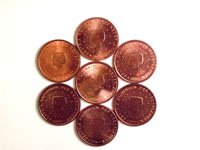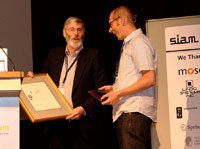The prestigious SIAG/Optimization Prize has been awarded to Frank Vallentin (Delft University of Technology and Centrum Wiskunde & Informatica) and Christine Bachoc (University of Bordeaux) for their research on the kissing number. In geometry this is the maximum number of balls that can simultaneously touch a central ball without overlapping. This research has applications in geometry, error correcting codes in telecommunications, and material science. The three-yearly international prize was awarded at the SIAM Conference on Optimization, which took place in Darmstadt, Germany, in May. The prize committee was “impressed by the mathematical sophistication of the approach”.
The kissing number problem is a classical, long-standing problem in geometry. In two dimensions the kissing number is six, which can be seen if you group euro coins around one central euro coin. The value in three dimensions was already disputed in 1694 by Isaac Newton and David Gregory, and was only determined in the 1950's to equal 12 (proving Newton was right). Starting from five dimensions, the exact value of the kissing number is unknown in most dimensions. In 2006, Vallentin and Bachoc found new upper bounds for 'kissing' in higher dimensions. They developed a new method, based on semi-definite programming, harmonic analysis, and invariant theory, resulting in the sharpest upper bounds currently known.

Prize committee
Vallentin and Bachoc received the SIAG/OPT prize for their paper ‘New upper bounds for kissing numbers from semidefinite programming’, which was published in the Journal of the American Mathematical Society in 2008. The prize from SIAM - the Society for Industrial and Applied Mathematics - is awarded every three years to the authors of “the most outstanding paper in optimization in the four years preceding the year of the award”. The committee considered this work “a fine example of the use of computational optimization to achieve progress in pure mathematics”.

These results were achieved while Vallentin was fully affiliated to CWI, as part of the VIDI research project of Monique Laurent and of the Spinoza project of Lex Schrijver. Since 2009, Vallentin is assistant professor in the Optimization and Systems Theory research group of the Delft University of Technology. He remained affiliated for one day a week to the group Algorithms, Combinatorics and Optimization of the Centrum Wiskunde & Informatica (CWI) in Amsterdam. Vallentin has been awarded an NWO VIDI grant in2009.
Picture 1: Frank Vallentin. Source: Jakob Schelbert.
Picture 2: Kissing number – illustration: Frank Vallentin (CWI, TUD)
Picture 3: Frank Vallentin (on the right) and Mike Todd - chair of the SIAM Activity group on Optimization, which awards the prize. Source: Jakob Schelbert.
More information:
Conference site: http://www.siam.org/meetings/op11/
SIAG/Optimization Prize: http://www.siam.org/prizes/sponsored/siagopt.php
Paper: C. Bachoc and F. Vallentin. New upper bounds for kissing numbers from semidefinite programming, J. Amer. Math. Soc. 21 (2008), 909-924.
Webpage Frank Vallentin: http://homepages.cwi.nl/~vallenti/RESEARCH.html
